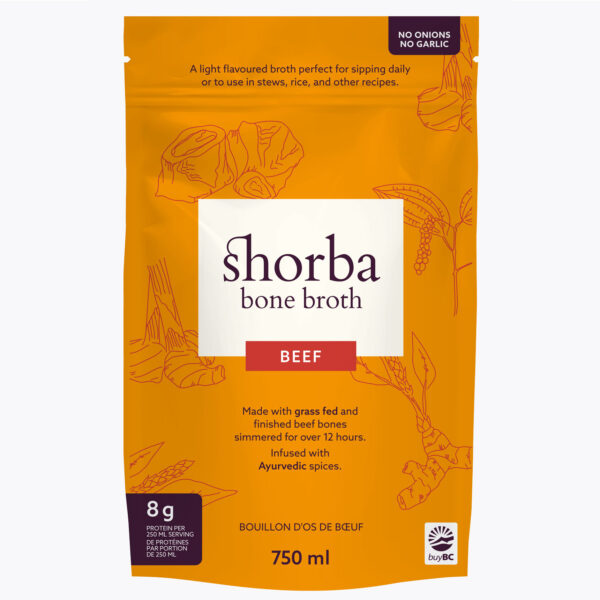Just How to Make Beef Bone Brew: A Step-by-Step Overview for Delicious Homemade Nutrition
Beef bone broth is a nutritious addition to any kitchen. It offers numerous health benefits and can boost a selection of recipes. The procedure starts with choosing the ideal bones and components. Comprehending each action is important for achieving the most effective flavor and richness. Lots of home chefs forget crucial techniques that can raise their broth. What are these techniques, and exactly how can they change an easy brew right into a culinary staple?
Understanding the Benefits of Beef Bone Brew
While lots of people delight in the rich taste of beef bone broth, they might not fully appreciate its many health advantages. This nourishing elixir is understood for its high collagen content, which supports joint health and promotes skin elasticity. The amino acids discovered in bone brew, such as glycine and proline, play substantial duties in muscular tissue fixing and digestive health and wellness. Additionally, it is abundant in minerals like calcium, phosphorus, and magnesium, essential for keeping solid bones and overall health. Bone brew also possesses anti-inflammatory residential or commercial properties, which can ease signs linked with persistent conditions. Consuming it might support intestine health by improving the mucosal lining of the digestive tract, promoting much better nutrient absorption. The heat and convenience of a steaming dish of broth can supply a relaxing impact, making it a nourishing and scrumptious choice for people looking for both cooking pleasure and health benefits.
Choosing the Right Bones
The structure of a healthy and savory beef bone broth lies in the choice of bones. For perfect outcomes, it is vital to select a range of bones that supply an abundant blend of flavor and nutrients. Marrow bones, which include the fatty, gelatinous marrow, are especially valued for their capability to boost the brew's richness. Joint bones, such as knuckles and oxtails, are additionally useful since they are high in collagen, adding to a silky appearance. Additionally, including some meaty bones can include depth to the flavor account. Sourcing bones from grass-fed or pasture-raised livestock is advisable, as these alternatives often tend to offer exceptional quality and preference. It is also important to establish the bones are fresh and totally free from any kind of off-putting odors. By carefully picking the ideal bones, one can prepare for a delicious and nourishing beef bone brew.
Important Components for Flavorful Broth
To produce a savory beef bone broth, picking high quality beef bones is important as they work as the structure of the dish - Where To Buy Bone Broth Near Me. Fragrant vegetables and a cautious selection of herbs and flavors even more boost the broth's deepness and complexity. With each other, these crucial active ingredients add to a abundant and enjoyable taste account
Quality Beef Bones
Quality beef bones work as the structure for a rich and delicious broth. The very best alternatives consist of marrow bones, knuckle bones, and oxtails, each contributing unique appearances and flavors. Marrow bones are prized for their jelly web content, which helps produce a smooth mouthfeel. Knuckle bones, rich in collagen, boost the brew's body and nutritional profile. Oxtails use a passionate preference and added richness. It is crucial to resource bones from grass-fed or pasture-raised livestock, as this improves the general quality and taste of the brew. Quality is additionally important; bones should be utilized within a couple of days of acquisition or frozen for later use. Choosing premium beef bones assures a delicious and nourishing last item.
Fragrant Veggies Choice
While selecting aromatic vegetables, one should think about the function they play in improving the general flavor profile of the beef bone broth. Usual selections consist of onions, carrots, and celery, often referred to as the "mirepoix." Onions add sweet taste and deepness, while carrots add a refined earthiness. Celery gives a renewing quality that stabilizes the splendor of the brew. Garlic, though optional, can introduce a robust taste, matching the mouthwatering notes of the beef. Leeks and shallots are likewise outstanding additions, offering one-of-a-kind preference dimensions. For a hint of heat and intricacy, some might include ginger or fennel. Picking a combination of these fragrant vegetables guarantees a flavorful and versatile broth, establishing the structure for a nourishing culinary experience.
Flavorful Herbs and Spices
Incorporating tasty herbs and seasonings is important for raising the taste of beef bone brew, as they introduce fragrant intricacy and depth. Usual options include bay leaves, which impart a refined organic note, and thyme, understood for its earthy flavor. Rosemary, with its pine-like essence, adds a revitalizing touch, while parsley contributes brightness and freshness. For a tip of warmth, black peppercorns and garlic are outstanding enhancements, improving the broth's total splendor. Additionally, pepper flakes or chili powder can introduce a mild heat for those that prefer a bit of flavor. Picking a balanced mix of these ingredients not just enhances taste but likewise infuses the brew with valuable nutrients, making it a beneficial and delicious option for any type of dish.
Preparing the Bones and Vegetables
To create a tasty and abundant beef bone brew, the preparation of vegetables and bones is crucial. First, choosing high-quality beef bones, such as knuckle, marrow, or oxtail, is crucial, as they give the necessary collagen and nutrients. Toasting the bones in the stove boosts their taste, giving the broth a much deeper, richer preference. It is recommended to roast them at 400 ° F for concerning thirty minutes, till browned.Next, vegetables play an essential function in structure flavor. Common selections include onions, carrots, and celery, referred to as the mirepoix base. These must be approximately sliced to take full advantage of flavor extraction during simmering. Garlic and tomatoes can additionally be consisted of for extra depth.Lastly, washing the veggies and bones under chilly water helps remove any kind of contaminations, making certain a clear brew. Effectively preparing veggies and bones sets the structure for a nourishing and delicious beef bone broth.
Cooking Methods: Stovetop vs. Slow Stove
The choice between stovetop and slow-moving cooker methods presents distinct advantages when it comes to cooking beef bone broth. Stovetop cooking permits quicker outcomes and more control over the simmering process, while slow-moving cookers offer convenience and an extensive infusion of tastes. Each method has its one-of-a-kind benefits, catering to different choices and timetables.

Stovetop Cooking Benefits
While both stovetop and slow-moving stove approaches have their merits, stovetop cooking supplies distinct advantages that can boost the process of making beef bone brew. One substantial advantage is the capability to regulate the temperature level and simmering time a lot more specifically, which can lead to excellent extraction of nutrients and tastes from the bones. Additionally, stovetop food preparation enables real-time modifications, making it possible for the cook to monitor the broth's consistency and preference throughout look at more info the process. The quicker food preparation time compared to slow down cookers can likewise be beneficial for those requiring brew in a much shorter timeframe. Moreover, the stovetop method urges a hands-on strategy, promoting a deeper link to the cooking process and possibly leading to a much more delicious end product.
Slow Stove Advantages
Making use of a slow-moving stove for making beef bone brew provides numerous unique advantages that interest numerous home cooks. One primary advantage is the comfort of set-it-and-forget-it food preparation. When the components are integrated, the sluggish cooker can operate unattended for hours, enabling a busy schedule without constant monitoring. Additionally, slow cookers maintain a consistent reduced temperature, which draws out tastes and nutrients efficiently gradually without the risk of steaming, leading to a richer brew. The power effectiveness of sluggish cookers additionally stands apart, as they use much less power contrasted to stovetops (Bone Broth Near Me). Furthermore, slow cookers usually have programmable settings, allowing precise control over cooking times, which improves the overall simplicity of broth prep work
Stressing and Keeping Your Brew
Straining and saving beef bone broth is a necessary step that assures a clear, flavorful end product. When the broth has actually simmered for the recommended time, it must be carefully poured with a great mesh strainer or cheesecloth into a big bowl or pot. This process eliminates any solids, such as meat, vegetables, and bones, ensuring a smooth consistency. To capture every little bit of flavor, pushing the solids carefully with a spoon can be beneficial.After straining, the brew must cool to area temperature level prior to being stored. It is best to utilize impermeable containers, such as glass jars or freezer-safe bags, to avoid fridge freezer maintain and burn freshness. Classifying the containers with the date is likewise advisable. The broth can be cooled for approximately a week or iced up for numerous months, making it a practical enhancement to future dishes. Proper storage assurances that the dietary advantages and tastes continue to be undamaged.
Imaginative Ways to Use Beef Bone Broth
Beef bone broth supplies a versatile foundation for a range of recipes, enhancing both flavor and nourishment. Home chefs can incorporate it into soups and stews, giving a rich base that grows the general preference. It can likewise be utilized as a food preparation fluid for grains, such as rice or quinoa, infusing them with added nutrients and flavor.Additionally, beef bone broth acts as an exceptional structure for sauces and sauces, providing complexity and splendor to dishes. For those looking for a healthy beverage, drinking cozy broth can be calming and beneficial. It can even be made use of in smoothies for a protein increase, though this here might call for some innovative flavor balancing.Ultimately, beef bone broth not only boosts everyday recipes yet additionally adds to a wholesome diet, making it a staple ingredient for cooking fanatics and health-conscious people alike.
Regularly Asked Concerns
How Much Time Can I Store Beef Bone Brew in the Fridge?
The inquiry of storage duration for beef bone broth in the fridge is essential. Generally, it can be securely saved for regarding three to five days, making certain freshness and high quality before intake official source or freezing for longer conservation.
Can I Freeze Beef Bone Broth, and for For how long?
Beef bone brew can be iced up efficiently, permitting expanded storage. When properly secured in impermeable containers, it can last up to 6 months in the freezer, protecting its flavor and nutritional advantages for later use.
Is It Safe to Make Use Of Bones From a Supermarket?
The security of using food store bones depends upon their source and handling. If properly sourced and stored, these bones can be secure for usage, giving crucial nutrients when ready correctly for brew.
Can I Make Beef Bone Brew in an Immediate Pot?
The Instant Pot is indeed ideal for making beef bone brew - Where To Buy Bone Broth Near Me. Its pressure cooking feature substantially minimizes cooking time while still drawing out rich tastes and nutrients, making it a convenient choice for busy home cooks

What Nutritional Distinctions Exist In Between Beef and Hen Bone Broth?
The nutritional distinctions in between beef and chicken bone broth largely depend on their collagen web content, amino acids, and mineral profiles. Beef broth generally has more collagen and minerals, while chicken brew is frequently lighter and easier to digest. The foundation of a healthy and savory beef bone broth lies in the choice of bones. To produce a tasty beef bone brew, selecting quality beef bones is important as they offer as the structure of the recipe. The best options include marrow bones, knuckle bones, and oxtails, each contributing special structures and tastes. While choosing aromatic vegetables, one must think about the function they play in improving the total taste profile of the beef bone brew. To produce a flavorful and abundant beef bone brew, the prep work of bones and vegetables is crucial.